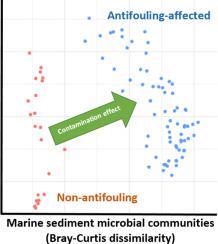当前位置:
X-MOL 学术
›
Sci. Total Environ.
›
论文详情
Our official English website, www.x-mol.net, welcomes your feedback! (Note: you will need to create a separate account there.)
Microplastic-antifouling paint particle contamination alters microbial communities in surrounding marine sediment
Science of the Total Environment ( IF 9.8 ) Pub Date : 2024-03-20 , DOI: 10.1016/j.scitotenv.2024.171863 A.S. Tagg , T. Sperlea , C. Hassenrück , B. Kreikemeyer , D. Fischer , M. Labrenz
Science of the Total Environment ( IF 9.8 ) Pub Date : 2024-03-20 , DOI: 10.1016/j.scitotenv.2024.171863 A.S. Tagg , T. Sperlea , C. Hassenrück , B. Kreikemeyer , D. Fischer , M. Labrenz

|
Paint used to coat surfaces in aquatic environments often contain biocides to prevent biofouling, and as these coatings degrade, antifouling paint particles (APPs) end up in aquatic, and especially marine, sediments. However, it is currently unclear what further influence APPs in the sediment have on biotic communities or processes. This study investigates how a variety of commercially-available APPs effect the marine microbial community by spiking different laboratory-manufactured APPs to sediment. Following exposure for 30 and 60 days, APPs caused a clear and consistent effect on the bacterial community composition as determined by 16S metabarcoding. This effect was strongest between 0 and 30 days, but continues to a lesser extent between 30 and 60 days. APPs appear to inhibit the highly diverse, but in general rarer, fraction of the community and/or select for specific community members to become more dominant. 71 antifouling-presence and 454 antifouling-absence indicator taxa were identified by indicator analysis. The difference in the level of classification in these two indicator groups was highly significant, with the antifouling-presence indicators having much higher percentage sequence identity to cultured taxa, while the antifouling-absence indicators appear to be made up of undescribed taxa, which may indicate that APPs act as a proxy for general anthropogenic influence or that APP contamination selects for taxa capable of being cultured. Given the clear and consistent effect APPs have on the surrounding sediment microbial community, further research into how APPs affect sediment functional processes and how such effects scale with concentration is recommended to better assess the wider consequences of these pollutants for marine biogeochemical cycles in the future. Microplastic-paint particles are commonly found in marine sediment but little is known about how these, especially antifouling, paint particles affect sediment microbial communities. This study demonstrates that antifouling paint particles fundamentally alter sediment microbial communities.
中文翻译:

微塑料防污涂料颗粒污染改变了周围海洋沉积物中的微生物群落
用于涂覆水生环境表面的涂料通常含有杀菌剂以防止生物污垢,随着这些涂料的降解,防污涂料颗粒 (APP) 最终会进入水生沉积物,尤其是海洋沉积物中。然而,目前尚不清楚沉积物中的 APP 对生物群落或过程有何进一步影响。本研究通过将不同的实验室制造的 APP 添加到沉积物中,研究了各种市售 APP 如何影响海洋微生物群落。根据 16S 元条形码的测定,暴露 30 天和 60 天后,APP 对细菌群落组成产生了明显且一致的影响。这种效应在 0 到 30 天之间最强,但在 30 到 60 天之间持续程度较小。应用程序似乎抑制了高度多样化但通常较少见的社区部分和/或选择特定社区成员变得更具主导性。通过指标分析,鉴定出71个防污存在指示类群和454个防污不存在指示类群。这两个指标组的分类水平差异非常显着,防污存在指标与培养类群的序列同一性百分比要高得多,而防污不存在指标似乎由未描述的类群组成,这可能表明APP 充当一般人为影响的代理,或者 APP 污染选择能够培养的类群。鉴于APP对周围沉积物微生物群落具有明显且一致的影响,建议进一步研究APP如何影响沉积物功能过程以及这种影响如何随浓度变化,以更好地评估这些污染物对未来海洋生物地球化学循环的更广泛影响。微塑料涂料颗粒常见于海洋沉积物中,但人们对这些颗粒(尤其是防污涂料颗粒)如何影响沉积物微生物群落知之甚少。这项研究表明,防污涂料颗粒从根本上改变了沉积物微生物群落。
更新日期:2024-03-20
中文翻译:

微塑料防污涂料颗粒污染改变了周围海洋沉积物中的微生物群落
用于涂覆水生环境表面的涂料通常含有杀菌剂以防止生物污垢,随着这些涂料的降解,防污涂料颗粒 (APP) 最终会进入水生沉积物,尤其是海洋沉积物中。然而,目前尚不清楚沉积物中的 APP 对生物群落或过程有何进一步影响。本研究通过将不同的实验室制造的 APP 添加到沉积物中,研究了各种市售 APP 如何影响海洋微生物群落。根据 16S 元条形码的测定,暴露 30 天和 60 天后,APP 对细菌群落组成产生了明显且一致的影响。这种效应在 0 到 30 天之间最强,但在 30 到 60 天之间持续程度较小。应用程序似乎抑制了高度多样化但通常较少见的社区部分和/或选择特定社区成员变得更具主导性。通过指标分析,鉴定出71个防污存在指示类群和454个防污不存在指示类群。这两个指标组的分类水平差异非常显着,防污存在指标与培养类群的序列同一性百分比要高得多,而防污不存在指标似乎由未描述的类群组成,这可能表明APP 充当一般人为影响的代理,或者 APP 污染选择能够培养的类群。鉴于APP对周围沉积物微生物群落具有明显且一致的影响,建议进一步研究APP如何影响沉积物功能过程以及这种影响如何随浓度变化,以更好地评估这些污染物对未来海洋生物地球化学循环的更广泛影响。微塑料涂料颗粒常见于海洋沉积物中,但人们对这些颗粒(尤其是防污涂料颗粒)如何影响沉积物微生物群落知之甚少。这项研究表明,防污涂料颗粒从根本上改变了沉积物微生物群落。



























 京公网安备 11010802027423号
京公网安备 11010802027423号